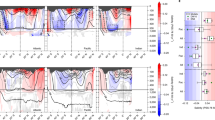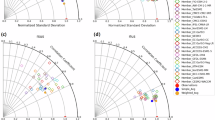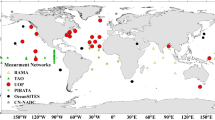Abstract
The current Earth's energy imbalance (EEI) is mostly caused by human activity, and is driving global warming. The absolute value of EEI represents the most fundamental metric defining the status of global climate change, and will be more useful than using global surface temperature. EEI can best be estimated from changes in ocean heat content, complemented by radiation measurements from space. Sustained observations from the Argo array of autonomous profiling floats and further development of the ocean observing system to sample the deep ocean, marginal seas and sea ice regions are crucial to refining future estimates of EEI. Combining multiple measurements in an optimal way holds considerable promise for estimating EEI and thus assessing the status of global climate change, improving climate syntheses and models, and testing the effectiveness of mitigation actions. Progress can be achieved with a concerted international effort.
This is a preview of subscription content, access via your institution
Access options
Subscribe to this journal
Receive 12 print issues and online access
$209.00 per year
only $17.42 per issue
Buy this article
- Purchase on SpringerLink
- Instant access to full article PDF
Prices may be subject to local taxes which are calculated during checkout




Similar content being viewed by others
References
Trenberth, K. E. & Stepaniak, D. P. Co-variability of components of poleward atmospheric energy transports on seasonal and interannual timescales. J. Clim. 16, 3691–3705 (2003).
Trenberth, K. E. & Stepaniak, D. P. Seamless poleward atmospheric energy transport and implications for the Hadley circulation. J. Clim. 16, 3706–3722 (2003).
Trenberth, K. E. & Stepaniak, D. P. The flow of energy through the Earth's climate system. Quart. J. Roy. Meteor. Soc. 130, 2677–2701 (2004).
Hansen, J., Sato, M., Kharecha P. & von Schuckmann, K. Earth's energy imbalance and implications. Atmos. Chem. Phys. 11, 13421–13449 (2011).
Trenberth, K. E., Zhang, Y., Fasullo, J. T. & Taguchi, S. Climate variability and relationships between top-of-atmosphere radiation and temperatures on Earth. J. Geophys. Res. 120, 3642–3659 (2015).
Trenberth, K. E., Fasullo J. T. & Balmaseda, M. A. Earth's energy imbalance. J. Clim. 27, 3129–3144 (2014).
Mayer, M. & Haimberger, L. Poleward atmospheric energy transports and their variability as evaluated from ECMWF reanalysis data. J. Clim. 25, 734–752 (2012).
England, M. H. et al. Recent intensification of wind-driven circulation in the Pacific and the ongoing warming hiatus. Nature Clim. Change 4, 222–227 (2014).
Myhre, G. et al. Radiative forcing of the direct aerosol effect from AeroCom Phase II simulations. Atmos. Chem. Phys. 13, 1853–1877 (2013).
Loeb, N. G. et al. Towards optimal closure of the earth's top-of-atmosphere radiation budget. J. Clim. 22, 748–766 (2009).
Abraham, J. P. et al. A review of global ocean temperature observations: Implications for ocean heat content estimates and climate change. Rev. Geophys. 51, 450–483 (2013).
Allan, R. P. et al. Changes in global net radiative imbalance 1985–2012. Geophys. Res. Lett. 41, 5588–5597 (2014).
Trenberth, K. E., Stepaniak, D. P. & Caron, J. M. Accuracy of atmospheric energy budgets from analyses. J. Clim. 15, 3343–3360 (2002).
Rhein, M. et al. in Climate Change 2013: The Physical Science Basis. (eds Stocker, T. F. et al.) 255–316 (IPCC, Cambridge Univ. Press, 2014).
Levitus, S. et al. World ocean heat content and thermosteric sea level change (0–2000 m), 1955–2010. Geophys. Res. Lett. 39, L10603 (2012).
Purkey, S. G. & Johnson, G. C. Warming of global abyssal and deep Southern Ocean waters between the 1990s and 2000s: contributions to global heat and sea level rise budgets. J. Clim. 23, 6336–6351 (2010).
Balmaseda, M. A., Trenberth K. E. & Kallen, E. Distinctive climate signals in reanalysis of global ocean heat content. Geophys. Res. Lett. 40, 1754–1759 (2013).
Church, J. A. et al. in Climate Change 2013: The Physical Science Basis (eds Stocker, T. F. et al.) 1137–1216 (IPCC, Cambridge Univ. Press, 2014).
Bindoff, N. L. et al. in Climate Change 2013: The Physical Science Basis (eds Stocker, T. F. et al.) 867–952 (IPCC, Cambridge Univ. Press, 2014).
Exarchou, E., Kuhlbrodt, T., Gregory, J. M. & Smith, R. S. Ocean heat uptake processes: a model intercomparison. J. Clim. 28, 887–908 (2015).
Meehl, G. A., Hu, A., Arblaster, J. M., Fasullo, J. T. & Trenberth, K. E. Externally forced and internally generated decadal climate variability in the Pacific. J. Clim. 26, 7298–7310 (2013).
Palmer, M. D., McNeall, D. J. & Dunstone, N. J. Importance of the deep ocean for estimating decadal changes in Earth's radiation balance. Geophys. Res. Lett. 38, L13707 (2011).
Trenberth, K. E. & Fasullo, J. T. An apparent hiatus in global warming? Earth's Future 1, 19–32 (2013).
Palmer M. D. & McNeall, D. J. Internal variability of Earth's energy budget simulated by CMIP5 climate models. Environ. Res. Lett. 9, 034016 (2014).
Cheng, L. & Zhu, J. Artifacts in variations of ocean heat content induced by the observation system changes. Geophys. Res. Lett. 41, 7276–7283 (2014).
Kosaka, Y. & Xie, S.-P. Recent global-warming hiatus tied to equatorial Pacific surface cooling. Nature 501, 403–408 (2013).
Roemmich, D., Church, J., Gilson, J., Monselesan, D., Sutton, P. & Wijffels, S. Unabated planetary warming and its ocean structure since 2006. Nature Clim. Change 5, 250–245 (2015).
Loeb, N. G. et al. Advances in understanding top-of-atmosphere radiation variability from satellite observations. Surv. Geophys. 33, 359–385 (2012).
Loeb, N. G. et al. Observed changes in top-of-the-atmosphere radiation and upper-ocean heating consistent within uncertainty. Nature Geosci. 5, 110–113 (2012).
Santer, B. D. et al. Volcanic contribution to decadal changes in tropospheric temperature. Nature Geosci. 7, 185–189 (2014).
Minnis, P. et al. Radiative climate forcing by the Mount Pinatubo eruption. Science 259, 1411–1415 (1993).
Wielicki, B. A. et al. Clouds and the Earth's radiant energy system (CERES): an Earth observing system experiment. Bull. Amer. Meteor. Soc. 77, 853–868 (1996).
Kopp, G. & Lean, J. L. A new, lower value of total solar irradiance: Evidence and climate significance. Geophys. Res. Lett. 38, L01706 (2011).
Loeb, N. G. et al. Toward optimal closure of the earth's top-of-atmosphere radiation budget. J. Clim. 22, 748–766 (2009).
Loeb, N. G., Kato, S., Loukachine, K. & Manalo-Smith, N. Angular distribution models for top-of-atmosphere radiative flux estimation from the clouds and the Earth's Radiant Energy System instrument on the Terra satellite. Part II: validation. J. Atmos. Oceanic Tech. 24, 564–584 (2007).
Doelling, D. R. et al. Geostationary enhanced temporal interpolation for CERES flux products. J. Atmos. Ocean. Tech. 30, 1072–1090 (2013).
Loeb, N. G., Kato, S., & Wielicki, B. A. Defining top-of-atmosphere flux reference level for earth radiation budget studies. J. Clim. 15, 3301–3309 (2002).
Church, J. A. et al. Revisiting the Earth's sea-level and energy budgets from 1961 to 2008. Geophys. Res. Lett. 38, L18601 (2011).
Josey, S. A., Gulev S. & Yu, L. in Ocean Circulation and Climate: A 21st Century Perspective 2nd edn (eds Siedler, G., Griffies, S., Gould, J. & Church, J.) Ch. 5, 115–140 (International Geophysics Series Vol. 103, Academic, 2013).
Woodruff, S. D. et al.: ICOADS release 2.5: extensions and enhancements to the surface marine meteorological archive. Int. J. Climatol. 31, 951–967 (2011).
Jin, X., Yu, L., Jackson, D. L. & Wick, G. A. An improved near-surface specific humidity and air temperature climatology for the SSM/I satellite period. J. Atmos. Oceanic Technol. 32, 412–433 (2015).
Bosilovich, M. G., Robertson, F. R. & Chen, J. Global energy and water budgets in MERRA. J. Clim. 24, 5721–5739 (2011).
Trenberth, K. E., Fasullo, J. T. & Mackaro, J. Atmospheric moisture transports from ocean to land and global energy flows in reanalyses. J. Clim. 24, 4907–4924 (2011).
Kobayashi, S. et al. The JRA-55 reanalysis: general specifications and basic characteristics. J. Meteor. Soc. Japan 93, 5–48 (2015).
Trenberth, K. E. & Fasullo, J. T. Regional energy and water cycles: Transports from ocean to land. J. Clim. 26, 7837–7851 (2013).
Valdivieso, M. et al. An assessment of air–sea heat fluxes from ocean and coupled reanalyses. Clim. Dyn. http://dx.doi.org/10.1007/s00382-015-2843-3 (2015).
Kato, S. et al. Surface irradiances consistent with CERES-derived top-of-atmosphere shortwave and longwave irradiances. J. Clim. 26, 2719–2740 (2013).
Rutan, D. A. et al. CERES synoptic product: methodology and validation of surface radiant flux. J. Atmos. Oceanic Technol. 32, 1121–1143 (2015).
Trenberth, K. E., Fasullo, J. T. & Kiehl, J. Earth's global energy budget. Bull. Am. Meteor. Soc. 90, 311–324 (2009).
Gouretski, V. & Koltermann, K. P. How much is the ocean really warming? Geophys. Res. Lett. 34, L01610 (2007).
Lyman, J. M. et al. Robust warming of the global upper ocean. Nature 465, 334–337 (2010).
Desbruyères, D. G. et al. Full-depth temperature trends in the Northeastern Atlantic through the early 21st century. Geophys. Res. Lett. 41, 7971–7979 (2014).
Von Schuckmann, K. et al. Monitoring ocean heat content from the current generation of global ocean observing systems. Ocean Sci. 10, 547–557 (2014).
Nerem, R. S., Chambers, D. P., Choe, C. & Mitchum, G. T. Estimating mean sea level change TOPEX and from the Jason missions. Marine Geodesy. 33, 435–446 (2010).
Ablain, M. et al. Improved sea level record over the satellite altimetry era (1993–2010) from the Climate Change Initiative project. Ocean Sci. 11, 67–82 (2015).
Johnson, G. F. & Chambers, D. P. Ocean bottom pressure seasonal cycles and decadal trends from GRACE release-05: ocean circulation implications. J. Geophys. Res. Oceans 118, 4228–4240 (2013).
Chen, J. L., Wilson, C. R. & Tapley B. D. Contribution of ice sheet and mountain glacier melt to recent sea level rise. Nature Geosci. 6, 549–552 (2013).
Llovel, W., Willis, J. K., Landerer, F. K. & Fukumori, I. Deep-ocean contribution to sea level and energy budget not detectable over the past decade. Nature Clim. Change 4, 1031–1035 (2014).
Dieng, H. B., Palanisamy, H., Cazenave, A., Meyssignac, B. & von Schuckmann, K. The sea level budget since 2003: inference on the deep ocean heat content Surv. Geophys. 36, 209–229 (2015).
Dieng, H. B., Cazenave, A., von Schuckmann, K., Ablain, M. & Meyssignac, B. Sea level budget over 2005–2013: missing contributions and data errors. Ocean Sci. 11, 789–802 (2015).
Watson, C. S. et al. Unabated global mean sea-level rise over the satellite altimeter. Nature Clim. Change. 5, 565–568 (2015).
Smith, D. M. et al. Earth's energy imbalance since 1960 in observations and CMIP5 models. Geophys. Res. Lett. 42, 1205–1213 (2015).
Wild, M. et al. The energy balance over land and oceans: an assessment based on direct observations and CMIP5 climate models. Clim. Dyn. 44, 3393–3429 (2015).
Trenberth, K. E. & Fasullo, J. T. Tracking Earth's energy. Science 328, 316–317 (2010).
Regayre, L. A. et al. Uncertainty in the magnitude of aerosol-cloud radiative forcing over recent decades. Geophys. Res. Lett. 41, 9040–9049 (2014).
Haigh J. D. et al. An influence of solar spectral variations on radiative forcing of climate. Nature 467, 696–699 (2010).
Katsman, C. A. & van Oldenborgh, G. J. Tracing the upper ocean's “missing heat”. Geophys. Res. Lett. 38, L14610 (2011).
Koehl, A. & Stammer, D. Decadal sea level changes in the 50-year GECCO ocean synthesis, J. Clim. 21, 1876–1890 (2007).
Carton, J. A. & Santorelli, A. Global decadal upper-ocean heat content as viewed in nine analyses. J. Clim. 21, 6015–6035 (2008).
Balmaseda, M. A., Mogensen K. & Weaver A. T. Evaluation of the ECMWF ocean reanalysis system ORAS4. Q. J. R. Meteorol. Soc. 139, 1132–1161 (2013).
Balmaseda, M. A. et al. The Ocean Reanalyses Intercomparison Project (ORA-IP). J. Oper. Oceanogr. 8, s80–s97 (2015).
Von Schuckmann, K. et al. A prospectus for the CLIVAR research focus: Consistency between planetary energy balance and ocean heat storage (CONCEPT-HEAT) Community White Paper (WCRP/CLIVAR, 2014).
Myhre, G. et al. in Climate Change 2013: The Physical Science Basis (eds Stocker, T. F. et al.) 659–740 (IPCC, Cambridge Univ. Press, 2014).
Von Schuckmann, K. & Le Traon, P.-Y. How well can we derive global ocean indicators from Argo data? Ocean Sci. 7, 783–791 (2011).
Roemmich, D. & Gilson, J. The 2004–2008 mean and annual cycle of temperature, salinity, and steric height in the global ocean from the Argo Program. Progr. Oceanogr. 82, 81–100 (2009).
Good, S. A., Martin M. J. & Rayner, N. A. EN4: quality controlled ocean temperature and salinity profiles and monthly objective analyses with uncertainty estimates. J. Geophys. Res. Oceans 118, 6704–6716 (2013).
Hosoda, S., Ohira, T., Sato, K. & Suga, T. Improved description of global mixed-layer depth using Argo profiling floats. J. Oceanogr. 66, 773–787 (2010).
Acknowledgements
Two meetings of this international working group have been supported by the International Space Science Institute (ISSI), Bern, Switzerland.
Author information
Authors and Affiliations
Contributions
K.v.S. led the formulation of the paper and produced Figs 2 and 4. M.P. produced Fig. 3. The main drafts of the paper were compiled by K.v.S., M.P. and K.T. All authors contributed to discussions, writing and figure development.
Corresponding author
Ethics declarations
Competing interests
The authors declare no competing financial interests.
Rights and permissions
About this article
Cite this article
von Schuckmann, K., Palmer, M., Trenberth, K. et al. An imperative to monitor Earth's energy imbalance. Nature Clim Change 6, 138–144 (2016). https://doi.org/10.1038/nclimate2876
Received:
Accepted:
Published:
Issue Date:
DOI: https://doi.org/10.1038/nclimate2876
This article is cited by
-
Acceleration of the ocean warming from 1961 to 2022 unveiled by large-ensemble reanalyses
Nature Communications (2024)
-
Vertical structures of marine heatwaves
Nature Communications (2023)
-
Asymmetric response of South Asian summer monsoon rainfall in a carbon dioxide removal scenario
npj Climate and Atmospheric Science (2023)
-
Robust acceleration of Earth system heating observed over the past six decades
Scientific Reports (2023)
-
How accurate is accurate enough for measuring sea-level rise and variability
Nature Climate Change (2023)



